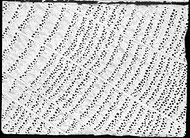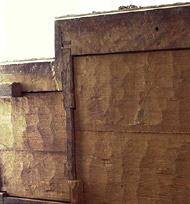Investment Quality Is Important
What Is Investment Quality?
As we all know, building a fine home using all upscale, natural materials is not an expense, it is usually the largest investment and equity producing asset a person can own.
As with any investment, the goal with investment quality furnishings is to earn appreciation on each dollar spent. In order for any item to become investment quality - whether it is your home, jewelry, furnishings or any other prized items - these investments must truly stand the test of time to become increasingly valuable. For this to become a reality, each item must be quality hand built and "The Real McCoy". In other words, mass produced false gold, cubic zirconium, paste board or veneer will never become true investment quality heirlooms. Simply put, a copy of a Picasso will never be worth more than the paper it's printed on.

Like the Ancient Pillars, the Finest Materials and Master Craftsmanship Need No Warranties
Table of Contents
- - H. J. Nick - Artist Designer
- * Investment Quality Is Important
- - Guarantee & Satisfaction Warranty
- - How it's Made
- - Fine Furnishings Begin with Natural Materials
- - How It's Made - Wood Products
- - Master Hand Carving Information
- - How Its Made "Iron" - Master Blacksmithing
- - Facts About Leather Furniture
- - Stone, Marble & Granite
- - Art Factory Fine Art Finish Procedures
- - Finishes To World Class Antiquity Standards
- - American Vintage Restoration
- - More Door Details / Installation Info
- - Original Art or Limited Edition
- - Become an Interior Designer
- - A True Story About Mary
- - Dealer Design Policies & Rules
- - Web Site Terms And Conditions
- - Policies and Terms - A Must Read
All Antiquities Were Built to Stand the Test of Time
Up until the turn of the 20th century, all quality furnishings were hand built by master craftsman with true pride of workmanship. The best quality craftsman used only the best natural materials and finishes. The greatest works were built with time-honored and traditional methods that are now known and referred to simply as "The Old Fashioned Way", and have since become increasingly valuable with age. These pieces are now sought after antiquities and collectibles. This proves that long-term ownership can give us good investments, potential family heirlooms, true pride of ownership, and a little immortality in our family history. These furnishings traditionally needed no warranties, because the quality was known to stand the test of time.
Family Heirlooms Become Priceless
Many of these furnishings are still found all over the world and are now in museums, classical estates, or in your very own home as a family heirloom. Some pieces are hundreds of years old, and as they have aged have become more beautiful from natural aging - what is know as natural patina from normal were and tear. The oxidation of natural patinas, regular wear, use, and time can age a fine furnishing and transform these furnishings into unique pieces of artwork. Examples of this quality and history are everywhere. They range from George Washington's handmade desk to the Besanon cabinet shown below, or your grandma or grandpa's old furnishings etc. that have been passed down through the generations of your family.
This also applies to the handmade furnishing you purchase today and plan to pass down through your family. These items are all priceless.
A Case Study - The Getty Cabinet
The Getty Cabinet is a French Renaissance Cabinet rediscovered at the Getty Center Cabinet, French, about 1580 with late-19th-century additions walnut, oak, paint, iron, brass, linen, and silk lining.
J. Paul Getty purchased the above cabinet in 1971 for $1,700 against the advisement of his curators who believed it to be a fake. The experts who examined the cabinet believed it was not a genuine 16th-century French Renaissance cabinet due to its immaculate condition and colored wax coating, concluding the cabinet to be a 19th-century Renaissance Revival piece. After a Getty curator visited an exhibition on Hugues Sambin, a 16th century woodworker, in 2001, they decided to re-examine the Getty Museum cabinet.
A team of scientists, curators and conservationists launched a thorough examination of the Museum's cabinet to determine the authenticity of the object. Using material dating techniques, such as dendrochronoly (tree-ring dating), carbon dating, and visually inspecting the piece's tool marks, all materials were traced back to the 16th century, providing the proof needed to authenticate the date of the cabinet.
About Tree-ring Dating Dendrochronology

Tree-ring dating, dendrochronology, of the oak wood used on the structural panels of the Getty cabinet, show the tree washarvested in Burgundy, France in late 1574 to early 1575, which coincides with the painted date of 1580 on the cabinet.
Source: www.getty.edu/art/exhibitions/cabinet

Rough tool marks on the cabinet backside, were created by a plane saw used in the 16th century woodworking.
Tool marks found indicate that all pieces of the cabinet were created on the same workbench and therefore in the same time period. Sawdust from the walnut surface wood, and linen and silk from the drawer lining were carbon dated to between 1400 and 1600. Further evidence was found in the household inventory, a historical evidence source, stating that two cabinets were in the residence, which also backs up the date of the Getty Museum cabinet.


Left: Getty Museum cabinet, c. 1580.
Right: Museum of Time, Besancon, France cabinet 1581.
Investment Quality Furnishings from ArtFactory.com
ArtFactory.com under direction of artist H.J. Nick, always strives to maintain the furniture manufacturing integrity to the level of this example of craftsmanship, no matter the style you choose in your custom designed furnishing.
You have probably heard - The "Rich" Get Richer and the "Poor" Get Poorer. Ever wonder why? Studies show it has very little to do with how much money a family earns. It has more to do with having an investment state of mind - the ability to discern the difference between an expense and a long term investment. Most Americans are focused on how cheap each item can be purchased for and sale prices, with little attention given to the true value of the item. While this works well for expense purchases on commodities such as food, clothing, cars, computers, etc., this never works well on long term, big ticket purchases such as your home, building products, or home furnishings, etc. The reason is, your home should be an investment, and as it gets older it appreciates in value - with the exception of things that have to be replaced because they are worn out or become out of date.
The so called Rich buy only "investment quality" and never purchase low quality homes, building products, or home furnishings that have to be replaced.
Maybe as you were growing up, your mom and dad or grandparents might have said something to the effect that they would rather save up for one good item that will last and they could be proud to own, rather than purchase many cheap low quality items just to fill the room. For example: Instead of purchasing items made from man-made plywood, veneered particle boards, tile, formica or corian, purchase solid wood handmade furniture, cabinets, countertops, and floor materials made from genuine solid wood, marble, stone, or granite. Solid wood furniture, cabinets, and doors will never need to be replaced, and will age with grace becoming more valuable over time, hence "The Rich Get Richer". The man-made furniture with fake backs, plywood, veneers, tile, faux stone, corian or formica will have to be replaced over and over again - here's where "The Poor Get Poorer"
When you purchase investment quality furnishings, doors, lighting and hardware they will appreciate and keep up with inflation or exceed most other investments.
For this reason, becoming wealthy has very little to do with a higher education or having a lot of extra money. It is truly making wise decisions and a state of mind that allows for you to pay once for a good value, and continue to grow wealth while enjoying living in your investment. Not to mention this type of investing has many other benefits, such as priceless family heirlooms that have rich meaning and the ability to pass on your legacy to future generations.
Throughout our American history - no matter the economic conditions - investing in yourself, your home and your legacy has always paid off.
This is the big secret to building true wealth. Simply declare yourself worthy of the best, invest in it, and enjoy. If you are interested in discussing quality fine art furnishings, furniture, and custom doors manufactured in the highest quality natural materials, call us today and speak with our master craftsmen about your project needs at 1-800-292-0008.


